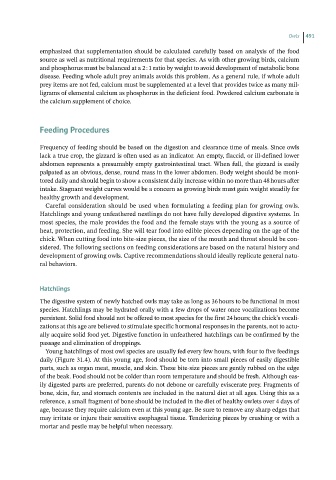Page 495 - Hand rearing birds second
P. 495
Owls 491
emphasized that supplementation should be calculated carefully based on analysis of the food
source as well as nutritional requirements for that species. As with other growing birds, calcium
and phosphorus must be balanced at a 2 : 1 ratio by weight to avoid development of metabolic bone
disease. Feeding whole adult prey animals avoids this problem. As a general rule, if whole adult
prey items are not fed, calcium must be supplemented at a level that provides twice as many mil-
ligrams of elemental calcium as phosphorus in the deficient food. Powdered calcium carbonate is
the calcium supplement of choice.
FeedingProcedures
Frequency of feeding should be based on the digestion and clearance time of meals. Since owls
lack a true crop, the gizzard is often used as an indicator. An empty, flaccid, or ill‐defined lower
abdomen represents a presumably empty gastrointestinal tract. When full, the gizzard is easily
palpated as an obvious, dense, round mass in the lower abdomen. Body weight should be moni-
tored daily and should begin to show a consistent daily increase within no more than 48 hours after
intake. Stagnant weight curves would be a concern as growing birds must gain weight steadily for
healthy growth and development.
Careful consideration should be used when formulating a feeding plan for growing owls.
Hatchlings and young unfeathered nestlings do not have fully developed digestive systems. In
most species, the male provides the food and the female stays with the young as a source of
heat, protection, and feeding. She will tear food into edible pieces depending on the age of the
chick. When cutting food into bite‐size pieces, the size of the mouth and throat should be con-
sidered. The following sections on feeding considerations are based on the natural history and
development of growing owls. Captive recommendations should ideally replicate general natu-
ral behaviors.
Hatchlings
The digestive system of newly hatched owls may take as long as 36 hours to be functional in most
species. Hatchlings may be hydrated orally with a few drops of water once vocalizations become
persistent. Solid food should not be offered to most species for the first 24 hours; the chick’s vocali-
zations at this age are believed to stimulate specific hormonal responses in the parents, not to actu-
ally acquire solid food yet. Digestive function in unfeathered hatchlings can be confirmed by the
passage and elimination of droppings.
Young hatchlings of most owl species are usually fed every few hours, with four to five feedings
daily (Figure 31.4). At this young age, food should be torn into small pieces of easily digestible
parts, such as organ meat, muscle, and skin. These bite‐size pieces are gently rubbed on the edge
of the beak. Food should not be colder than room temperature and should be fresh. Although eas-
ily digested parts are preferred, parents do not debone or carefully eviscerate prey. Fragments of
bone, skin, fur, and stomach contents are included in the natural diet at all ages. Using this as a
reference, a small fragment of bone should be included in the diet of healthy owlets over 4 days of
age, because they require calcium even at this young age. Be sure to remove any sharp edges that
may irritate or injure their sensitive esophageal tissue. Tenderizing pieces by crushing or with a
mortar and pestle may be helpful when necessary.

